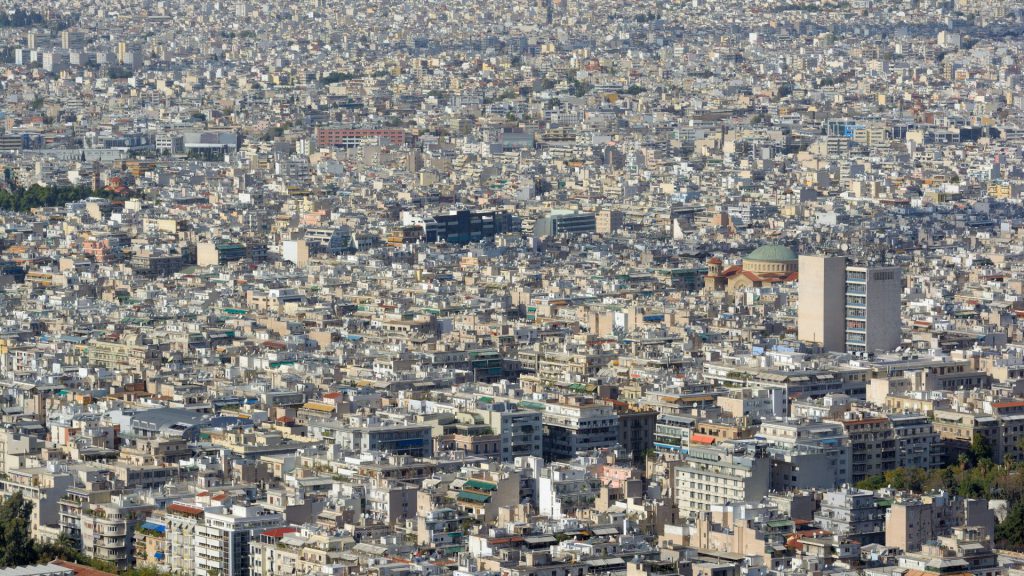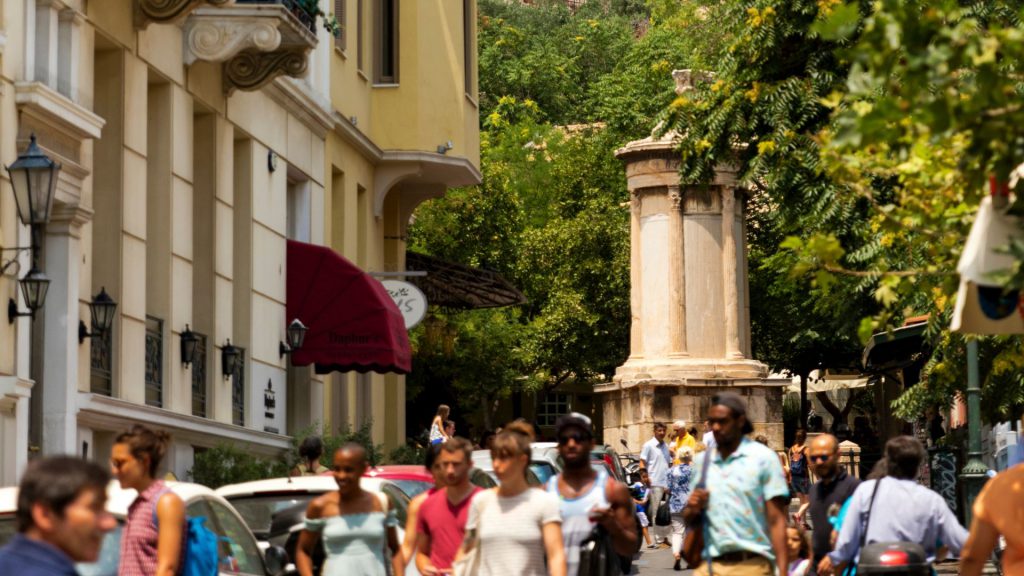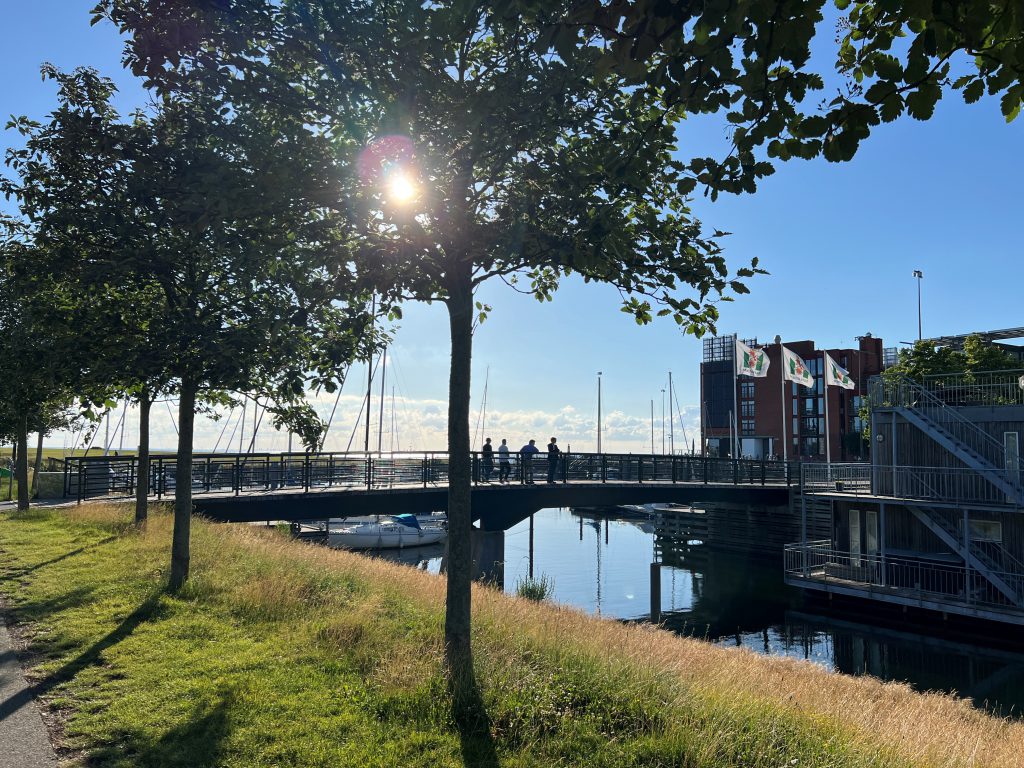From local to global ‒ multisectoral policy making can save people from extreme heat
Published 12 November, 2024
Teresia Borgman
Communications Officer at SLU
Awareness raising, preparedness, and re-design are three important pillars of developing heat-resilient cities. Working across sectors and collaborating between cities and national governments are key for policy work on urban heat. Eleni Myrivili shares local and global perspectives from her work as Chief Heat Officer for the city of Athens and Global Chief Heat Officer at the United Nations Human Settlement Program (UN Habitat).
In a nutshell
- Governments and policy makers play an important role in reducing heat-risk in cities, from local to global level, to facilitate policy development and international collaboration, networking, and knowledge exchange between cities and nations.
- Awareness raising, preparedness, and redesign are three important pillars of developing heat-resilient cities
- Vulnerable groups and urban population’s health need to be at the centre of policies on urban heat.
- Multisectoral collaborations are key to tackling urban heat. Policies on labour, the health sector, energy and the environment, transportation, buildings and infrastructure are some of the many areas that need to be included in cross-sectoral work to cope with urban heat.
- Landscape architecture is central to redesigning cities to create cool conditions for people’s health and wellbeing.
Urban heat has been at the centre of Eleni Myrivili’s work since 2016. As elected member of the Athens City Council (2014-2019) and appointed as Chief Resilience Officer she realised that extreme heat was a serious recurring shock and stress for the city of Athens. Soon after, as Athens Deputy Mayor for Urban Nature Urban Resilience and Climate Adaptation, she managed to start implementing climate resilient initiatives.
In the summer of 2021, Eleni Myrivili was appointed by Arsht-Rock Resilience Center of the Atlantic Council in Washington and the new Mayor of Athens as the Chief Heat Officer, where her focus has been to build heat resilience in the city of Athens. She was the first such appointment in Europe. In 2023 she joined the United Nations Habitat for Human Settlements program UN Habitat seconded by the Arsht-Rock Resilience Center as the first Global Chief Heat Officer where her aim is to raise the topic of heat in the UN agenda and create a larger global advocacy strategy for extreme heat.
Still today we’re not prepared for extreme heat and are not making it a priority in our policy making”
– Eleni Myrivili
“Heat, global warming, the mother of most recent extreme weather events: heatwaves, drought and wildfires, even hurricanes and flooding. Extreme heat also severely impacts all of our critical systems: water, energy, food, transportation and communications. I started focusing on heat because it seemed like everybody was talking about sea level rise and flooding – and nobody was talking about heat, urban heat. And still today we’re not prepared for extreme heat and are not making it a priority in our policy making,” says Eleni Myrivili.

Photo: Leonhard Niederwimmer, Pixabay
Networking for Sustainable Cities
As Chief Heat Officer in Athens, she has been working with other cities in networks like the Resilient Cities Network and C40 Cities, collaborating to figure out the science, technologies and local solutions and policies that can protect people from extreme heat.
Resilient Cities Network consists of cities that are committed to building and investing in urban resilience, in the wider sense, defined by the network as “the capacity of individuals, communities, institutions, businesses and systems within a city to survive, adapt and grow, no matter what kinds of chronic stresses and acute shocks they experience.”
The C40 Cities is a global network of mayors and cities that focus on climate action and are committed to using an inclusive, science-based, and collaborative approach to cut emissions and limit global heating as well as building healthy, equitable, and resilient communities. The city of Athens has been lead city of C40’s Cool Cities group focusing on heat.
Awareness raising, preparedness, and redesign of cities
Calls for an urban design revolution led by landscape architects
Eleni Myrivili has argued for a paradigm shift and an “urban design revolution” led by landscape architects to take on extreme heat waves, as well as three pillars of heat resilience actions.
1) Awareness, which includes all the knowledge and science around extreme heat, such as all the efforts to communicate it, including campaigns, alerts and capacity building.
2) Preparedness, which includes all the short-term and immediate efforts to address exposure and vulnerability of populations (such as ecosystems, agriculture and infrastructure) during periods of extreme heat, and
3) Redesign, which includes all the long-term planning that needs to take place at national and subnational levels to prepare our systems and cities for a much hotter future.
“Instead of prioritizing buildings and development, and leaving little space for landscape architects to create greening, we need to include landscape architects first of all,” she argues. “We now have scientific data that link trees to people’s survival in increasingly hot cities.”
The best defence that we have in cities against heat, is to include more nature”
– Eleni Myrivili
“The best defence that we have in cities against heat, is to include more nature and make truly nature-positive cities. We have to redesign cities by prioritizing trees and water-permeable surfaces instead of private cars and parking spots”, she argues.
The world’s cities are heating up at twice the global average rate due to rapid urbanization and the urban heat island, she explains. The Urban Heat Island (UHI) describes the phenomenon that urban centres are usually warmer than the surrounding rural areas due to several factors, including heat-trapping due to the proximity of tall compact buildings, waste heat generated from human activities, such as cars and air conditioning), the heat-absorbing and heat-radiating properties of concrete, asphalt and other materials used in urban surfaces. Finally, urban centres are hotter due to population density and the diminishing blue spaces, green cover and vegetation.

“Redesigning our cities means reclaiming part of the public space currently covered by concrete and asphalt for slow mobility, water permeable soil, and trees. It means day-lighting rivers that we’ve buried under highways. It means connecting existing green spaces to support biodiversity. These are considerations and principles best supported by the discipline of landscape architecture and the ways it approaches the urban landscapes in contrast to development construction and architectural approaches to the city,” says Eleni Myrivili.
Ideally, when we create new cities or new neighborhoods, we have to go first to the landscape architects and create conditions for trees and water and allow buildings to be positioned so that the wind flows properly, nature and biodiversity can thrive and people can be healthy and able to move around.”
– Eleni Myrivili
“Urban planners usually prioritize buildings and as an after-thought leave little spaces for a park or a garden. Ideally, when we create new cities or new neighbourhoods, we have to go first to the landscape architects and create conditions for trees and water and allow buildings to be positioned so that the wind flows properly, nature and biodiversity can thrive and people can be healthy and able to move around.”
Some examples from Athens include designing three “green corridors”, which connect existing green spaces with roads that are pedestrianized, have permeable surfaces and shading provided by double or triple rows of trees. Another example is the reuse of resilient infrastructure, of a monument, tapping into a Roman aqueduct, built two thousand years ago underneath the city spanning 24 km and still moving large unused amounts of clean water. The water will be used to irrigate existing and new green spaces over these 24 kilometres. Finally, new parks, large and small, are designed and are sprouting all over this densely built city.

Awareness raising and preparedness
Local governments play an important role in reducing heat risk, argues Wan-Yu Shih, Associate Professor in the Department of Urban Planning and Disaster Management at Ming-Chuan University, Taiwan in the article City planning for heat waves must be strategic.
However, in a study about people’s experiences from the 2022 heatwave in Nottingham, England, few interviewees recollected getting any heat advice from the council or national government.
The Indian city of Ahmedabad was a pioneer as the first South Asian city to introduce a Heat Action Plan after the severe heatwave in 2010. This was launched in 2013 and included an early warning system for extreme heat and advice on how to prevent heat stress.
Making heat-related data and science easily accessible
Similarly, in Athens, a trailblazing smartphone app, the EXTREMA Global app, offers personalized heat-risk information and a map with the nearest cool spots in the city and the coolest routes from point A to B, incorporating heatwave categorization and early warning systems and land-surface temperature maps developed for the city.
When you know what the risks are then you can do something about it, you can create policies that will warn and protect people during heatwaves”
– Eleni Myrivili
The EXTREMA app is one of the ways that people in Athens get heat-related information. One of Eleni Myrivili’s objectives is to make heat-related data and science easily accessible, raise awareness and try to change behaviours when it comes to heat, not only for city planners and designers but also for urban dwellers, especially the most vulnerable ones.
“After Awareness comes Preparedness. When you know what the risks are then you can do something about it, you can create policies that will warn and protect people during heatwaves”, she says.
“How do we make sure that people understand how dangerous heat is and how we can provide solutions for them to protect themselves? How can we make our critical systems more robust during heatwaves, so we don’t have energy or water shortages? Long periods of extreme heat can put a lot of pressure on our cities’ economies, primarily through losses in productivity, on our cities’ health systems, our cities infrastructures that are not built to withstand prolonged high temperatures, but also logistics such as food and medicine ‘cold chains’.”
Protecting vulnerable groups
“One of the first things that cities have to do is to figure out who the most vulnerable populations are, and how to protect them from extreme heat. What policies and which parts of the cities should be prioritised? How do we make it so that the right information reaches the vulnerable people? Can we make sure we have backups for our critical systems like health, energy and water? And how do we create the legal framework, financial support, and/or insurance tools that can allow people not to risk their lives to make their daily wages? How do we best arrange our lives and the city regarding extreme heat?
The way I’ve always seen my mandate was to protect vulnerable people as cities get hotter and to try to make the cities cooler in general. I am now trying to scale all this up, and bring the issue of heat resilience higher up in both UN habitat and the UN agenda”
– Eleni Myrivili
“The way I’ve always seen my mandate was to protect vulnerable people as cities get hotter and to try to make the cities cooler in general. I am now trying to scale all this up, and bring the issue of heat resilience higher up in both UN habitat and the UN agenda,” she explains.
Vulnerability in cities varies and Eleni Myrivili emphasizes that each city has to study the local conditions and the type of measures that are particularly suited there.
“Elderly people are particularly vulnerable”
“In Athens, we are specifically focussing on elderly people living alone, as they are particularly vulnerable and comprise close to 20 per cent of our population. In other cities, there may be a need to focus on other vulnerable groups like women, low-wage workers, or people living in informal settlements. Other vulnerabilities need to be considered as well, people with pre-existing health conditions, including mental health, or people living in poorly constructed buildings or neighbourhoods with poor infrastructure.
In the study from the Nottingham heatwave in 2022, the authors recommended that the communities that are likely to suffer the most from heatwaves need to be the top priority for future research, such as people experiencing homelessness and vulnerable migrants.
According to Eleni Myrivili cities need to create green areas especially in vulnerable to heat-poor or marginalised neighbourhoods. They often have no parks or green areas, where they can get a respite from the heat. She remembers interviewing refugees who had come to Athens in 2015 due to the war in Syria, and how they were talking about the parks in the city.
“Suddenly our parks were full of people, and they considered the parks to be their favourite thing about Athens, which is something that not many Athenians would agree upon.”
Multisectoral approaches are key to protecting people from heat
“There is a need for multi-sectoral approaches interconnecting heat and health with urban design, building codes, energy regulations and labour policies,” argues Eleni Myrivili.
“Globally, we should be creating a multi-sectoral approach to heat that ranges from health to infrastructure, taking all these aspects into consideration and shifting the way we create policy.”

Labour policies to protect workers
One of the crucial issues relating to rising temperatures involves labour policymaking. People working under conditions of extreme heat may be exposing themselves to high levels of mortality and morbidity risk. Studies show that work-related injuries increase with heat.
“We have to figure out how to protect people that work under conditions that expose them to extreme heat”, says Eleni Myrivili.
Studies show that work-related injuries increase as temperature rises. A study from UCLA in 2021 looking at 11 million cases of work-related accidents showed that on days with higher temperatures workers had a much higher incidence of injuries. Heat-related workplace injuries were also much more likely among workers in lower-paying jobs.
We have to figure out how to protect people that work under conditions that expose them to extreme heat”
– Eleni Myrivili
“This concerns sectors such as construction work, agriculture, and other types of work, of the part of the informal sector. Seasonal and immigrant labourers are often particularly vulnerable. We must create protections globally for these people,” argues Eleni Myrivili.
Capacity building in the health sector
The health sector is another critical area that needs adaptation to rising temperatures, argues Eleni Myrivili. The health system needs to prepare and build capacity among its workers regarding heat-related illnesses.
“We need to make sure that health and social workers recognize the symptoms correctly, know how to best treat heat illnesses all the way to understand how medications might be affected by heat, or an overheated body to specific medication. There are many aspects to be considered when preparing the health sector for extreme heat, including being prepared to manage serious health illness without air-conditioning, and how to best support, for instance, delivery and neonatal units or children with heatstroke.”
Infrastructure withstanding heat
The infrastructure sector also needs to adapt to our new climate reality and, for example, start to use materials that can withstand higher temperatures.
“In the summer of 2022, the Hammersmith Bridge in London was covered in insulation foil, because they worried about its integrity after cracks produced by unprecedented heat in the material. This is one example showing that we really have to rethink our infrastructure in our cities; train tracks tend to buckle, asphalts start to melt, electricity wires sag, smartphones shut down, and airplanes cannot lift off as the air becomes less dense during extremes”, Eleni Myrivili says.
Heat and health – new initiatives on the global agenda
Urgent need for climate adaptation
There is still persistent global inaction over the climate emergency, concludes the authors of The Lancet Countdown report 2023. People and their health must be kept at the centre of policies, according to the report.
Another report from the World Resources Institute (WRI) Ross Center for Sustainable Cities based on new global data from the 1000 largest cities also highlights the urgent need for climate adaptation.
According to the 2023 report of the Lancet Countdown on health and climate change, 50 per cent of countries at the UN General Debate in 2022, mentioned the intersection of health and climate change, a decrease from 2021.
Growing engagement on health and climate change
The engagement on health and climate change is, however, growing among the public and decision-makers, according to Lancet Countdown.
Eleni Myrivili highlights several positives, such as initiatives, organisations, and networks working with the risks of urban heat from local to global level. At the global level, she highlights the system Early Warnings for All initiative of the UN Secretary-General, as well as his Call to Action on Extreme Heat this summer, both landmark moments regarding the heat-health nexus. As far as cities go, UN Habitat works in over 90 countries to “promote socially and environmentally sustainable towns and cities”, engaging people “bottom-up” as well as “government-down”.
New initiatives on heat and health
A significant initiative that was launched at COP28 by UN-Habitat and the Global Covenant of Mayors is the Coalition For High Ambition Multilevel Partnerships (CHAMP), promoting multilevel collaboration of cities and their governments, in an effort to mainstream their plans for reducing emissions, climate adaptation and loss of biodiversity.
The topic of heat and health was also high on the agenda at the COP28 meeting in 2023 with many new initiatives and pledges, such as COP28 UAE Declaration On Climate And Health and the Climate and Health Fund. The Global Cooling Pledge was another important initiative that was launched at COP28 by the UNEP led Cool Coalition. The Cool Coalition has brought together a broad church of partners committed to promoting globally a triple strategy: passive cooling, efficiency and phasing down the greenhouse gas HFCs (hydrofluorocarbons). These measures can achieve more than 60 per cent reduction below projected 2050 emissions while protecting 3,5 billion people from heat through access to cooling, while a third of this emission reduction is delivered through passive measures (nature, urban design, smart buildings, reflecting materials). More than 70 member states signed the Global Cooling Pledge and its actionable commitments at COP28.
“It is really important that we have managed to get countries interested and commit to pledges regarding funding and actions on health and climate nexus,” reflects Eleni Myrivili after attending the COP28 in 2023. “Also, cities, their challenges and needs, were present more than ever before in important discussions and ministerial meetings, such as for instance on UNH’s first ministerial on urbanization and climate change.”
The Global Heat Health Information Network is another initiative run by scientists, practitioners, and policymakers to improve capacity to protect people from heat-related health risks.
Health-related initiatives at COP29
At the UN Climate Change Conference COP29 in Baku, Azerbaijan, in November 2024, we are expecting resolutions that have to do with financing climate work, especially financing for “loss and damages”, adaptation”, and “resilience”. Also, more health-related initiatives connecting to climate and cities will be launched, such as a coalition on climate and health and Multisectoral Actions Pathways (MAP) for Resilient and Healthy Cities, where one of the key topics will be to integrate the health component in city planning. The initiatives were presented at an open webinar by the World Health Organization, WHO, and the COP29 presidency.
“It is significant that we make sure policies are streamlined at different levels of government. That is the only way to move forward with designing, implementing and financing initiatives together,” says Eleni Myrivili.
Urban heat series
The article is part of the Urban Heat series developed by SLU Urban Futures within the theme Urban healthscapes
Read more about the Urban Heat series.
Read our other article in the series:
Extreme urban heat – a serious threat in cities and a contemporary health hazard
The Heat Action Platform – Heat Action Platform (onebillionresilient.org)
2023 Report – Lancet Countdown
2024 Report – Lancet Countdown
Lancet infographic – Climate Countdown 2023
WRI Ross Center for Sustainable Cities | World Resources Institute
Heat Health Risks | Global Heat Health Information Network (ghhin.org)
European State of the Climate 2023
Urban Heat: The Athens Case Study (worldbank.org)
Global Cool Cities Alliance (GCCA)
Protecting children from heat stress: A technical note | UNICEF
Announcement of COP29 Health Initiatives (who.int)
Ahmedabad Climate Resilient City Action Plan
Zero: What Extreme Heat Means for Your Health – Bloomberg
The Global Climate and Health Alliance
Jodhpur Heat Action Plan 2023 | Global Heat Health Information Network (ghhin.org)
Heat stress in cities is unevenly distributed (univie.ac.at)
Värmeböljor största klimathotet mot människors hälsa — Folkhälsomyndigheten (folkhalsomyndigheten.se) (in Swedish only)
Hälsokonsekvenser av klimatförändring i Sverige – En risk- och sårbarhetsanalys — Folkhälsomyndigheten (folkhalsomyndigheten.se) (in Swedish only)
Share
Co-creation!
Do you miss something here? Would you like to contribute? Please let us know: urbanfutures@slu.se

